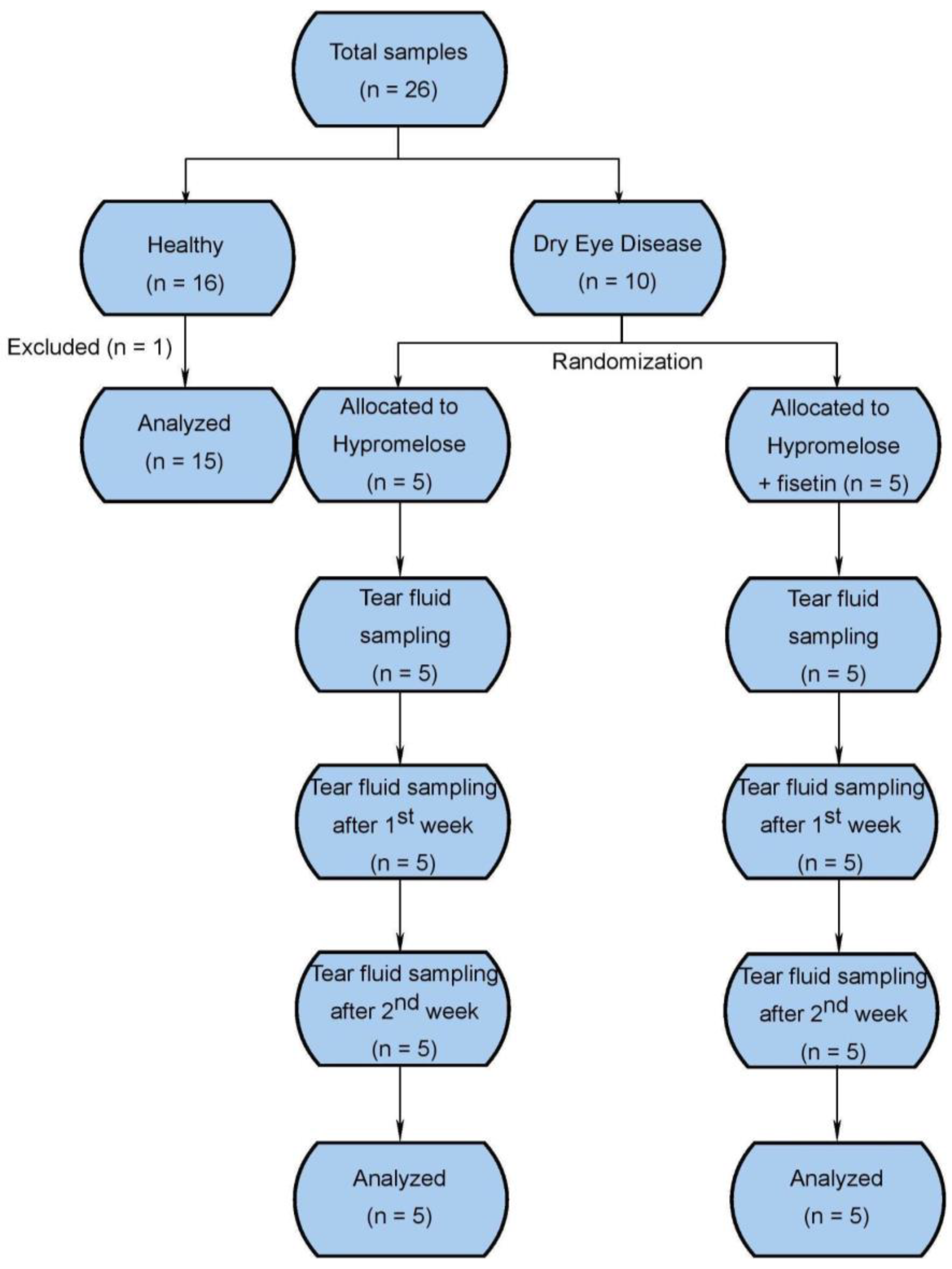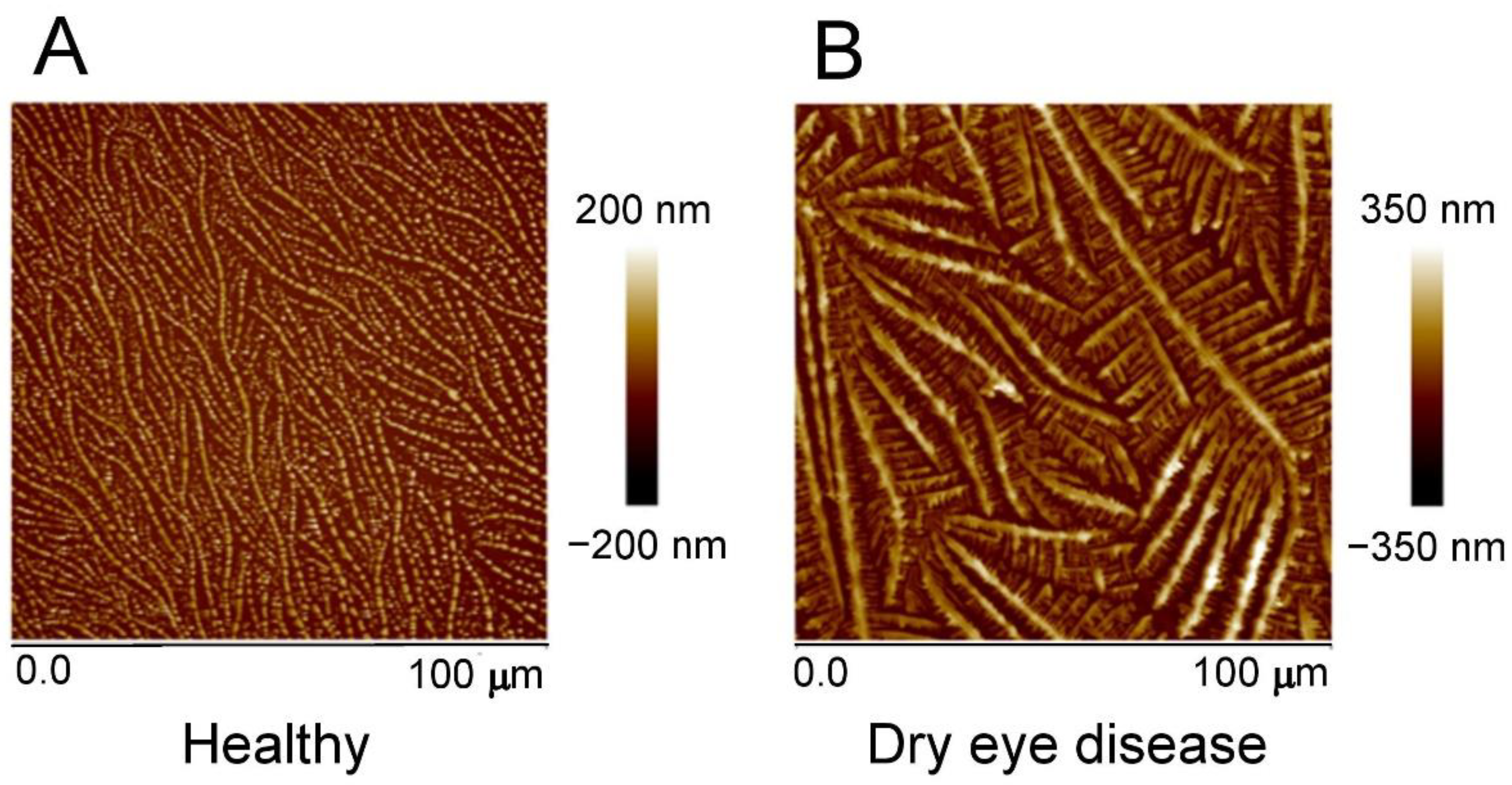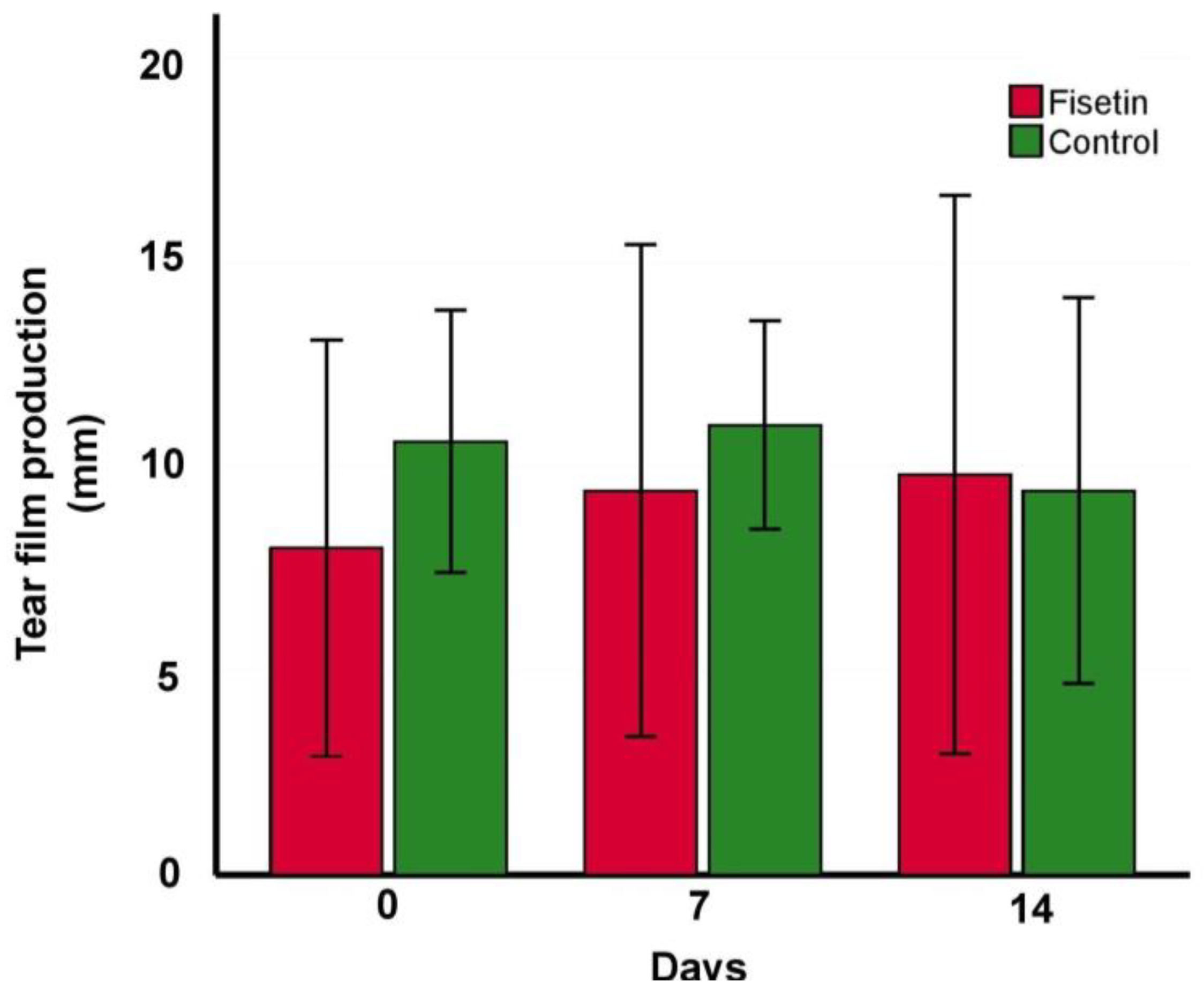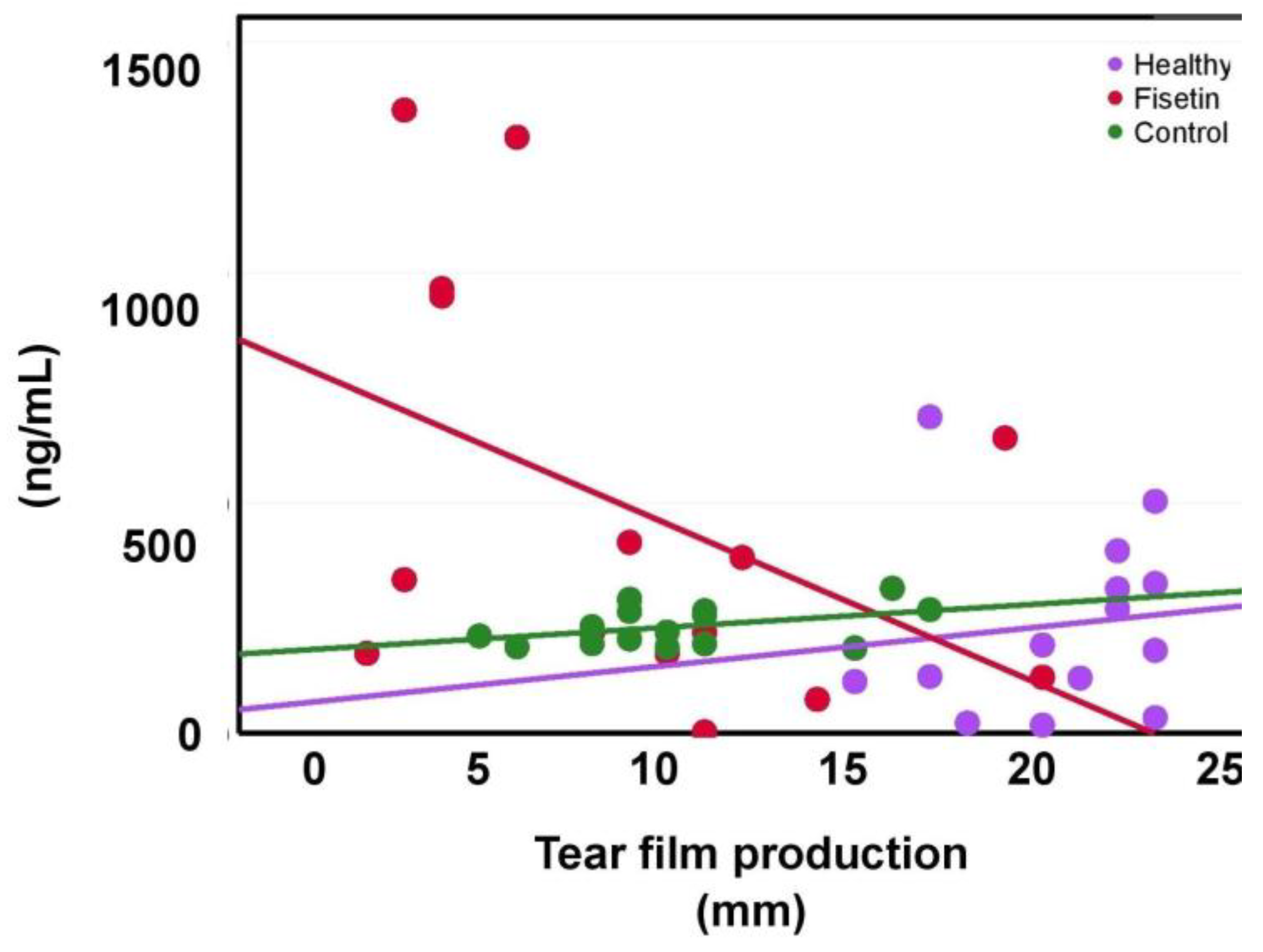The Effects of Fisetin on Cyclosporine-Treated Dry Eye Disease in Dogs
Abstract
:1. Introduction
2. Results
2.1. Study Design and Population Characteristics
2.2. Atomic Force Microscopy
2.3. Tear Film Production
2.4. Tear Film MMP-9 Level
2.5. The Dependence of MMP-9 on Tear Production
3. Discussion
4. Materials and Methods
4.1. Study Design
4.2. Participants
4.3. Tear Film Collection and Extraction
4.4. MMP-9 Enzyme-Linked Immunosorbent Assay
4.5. Atomic Force Microscopy
4.6. Statistical Analysis
Author Contributions
Funding
Institutional Review Board Statement
Informed Consent Statement
Data Availability Statement
Acknowledgments
Conflicts of Interest
References
- Bron, A.; de Paiva, C.; Chauhan, S.; Bonini, S.; Gabison, E.; Jain, S.; Knop, E.; Markoulli, M.; Ogawa, Y.; Perez, V.; et al. TFOS DEWS II pathophysiology report. Ocul. Surf. 2017, 15, 438–510. [Google Scholar] [CrossRef] [PubMed]
- De Paiva, C. Effects of aging in dry eye. Int. Ophthalmol. Clin. 2017, 57, 47–64. [Google Scholar] [CrossRef] [PubMed] [Green Version]
- Craig, J.; Wang, M.; Ambler, A.; Cheyne, K.; Wilson, G. Characterising the ocular surface and tear film in a population-based birth cohort of 45-year old New Zealand men and women. Ocul. Surf. 2020, 8, 808–813. [Google Scholar] [CrossRef] [PubMed]
- Peck, T.; Olsakovsky, L.; Aggarwal, S. Dry eye syndrome in menopause and perimenopausal age group. J. Midlife Health 2017, 8, 51–54. [Google Scholar] [CrossRef]
- Fraunfelder, F.; Sciubba, J.; Mathers, W. The role of medications in causing dry eye. J. Ophthalmol. 2012, 2012, 285851. [Google Scholar] [CrossRef] [PubMed] [Green Version]
- Kojima, T. Contact lens-associated dry eye disease: Recent advances worldwide and in Japan. Investig. Ophthalmol. Vis. Sci. 2018, 59, 102–108. [Google Scholar] [CrossRef] [Green Version]
- Demirci, G.; Karaman, E.; Ozsutcu, M.; Eliacik, M.; Olmuscelik, O.; Aydin, R.; Kocabora, M. Dry eye assessment in patients with vitamin D deficiency. Eye Contact Lens 2018, 44, 62–65. [Google Scholar] [CrossRef]
- Lee, M.; Sarossy, M.; Zamir, E. Vitamin A deficiency presenting with ‘Itchy Eyes’. Case Rep. Ophthalmol. 2015, 6, 427–434. [Google Scholar] [CrossRef]
- Tandon, R.; Vashist, P.; Gupta, N.; Gupta, V.; Sahay, P.; Deka, D.; Singh, S.; Vishwanath, K.; Murthy, G. Association of dry eye disease and sun exposure in geographically diverse adult (≥40 years) populations of India: The SEED (sun exposure, environment and dry eye disease) study—Second report of the ICMR-EYE SEE study group. Ocul. Surf. 2020, 18, 718–730. [Google Scholar] [CrossRef]
- Calonge, M.; Pinto-Fraga, J.; González-García, M. Effects of the external environment on dry eye disease. Int. Ophthalmol. Clin. 2017, 57, 23–40. [Google Scholar] [CrossRef]
- De Paiva, C.; Pangelinan, S.; Chang, E.; Yoon, K.-C.; Farley, W.; Li, D.-Q.; Pflugfelder, S. Essential Role for c-Jun N-Terminal Kinase 2 in Corneal Epithelial Response to Desiccating Stress. Arch. Ophthalmol. 2009, 127, 1625–1631. [Google Scholar] [CrossRef] [PubMed] [Green Version]
- Guzmán, M.; Keitelman, I.; Sabbione, F.; Trevani, A.; Giordano, M.; Galletti, J. Desiccating stress-induced disruption of ocular surface immune tolerance drives dry eye disease. Clin. Exp. Immunol. 2016, 184, 248–256. [Google Scholar] [CrossRef] [PubMed] [Green Version]
- De Paiva, C.; Corrales, R.; Villarreal, A.; Farley, W.; Li, D.-Q.; Stern, M.; Pflugfelder, S. Corticosteroid and doxycycline suppress MMP-9 and inflammatory cytokine expression, MAPK activation in the corneal epithelium in experimental dry eye. Exp. Eye Res. 2006, 83, 526–535. [Google Scholar] [CrossRef]
- Deng, R.; Hua, X.; Li, J.; Chi, W.; Zhang, Z.; Lu, F.; Zhang, L.; Pflugfelder, S.; Li, D.-Q. Oxidative Stress Markers Induced by Hyperosmolarity in Primary Human Corneal Epithelial Cells. PLoS ONE 2015, 10, e0126561. [Google Scholar] [CrossRef] [Green Version]
- Periman, L.; Mah, F.; Karpecki, P. A Review of the Mechanism of Action of Cyclosporine A: The Role of Cyclosporine A in Dry Eye Disease and Recent Formulation Developments. Clin. Ophthalmol. 2020, 14, 4187–4200. [Google Scholar] [CrossRef]
- Sansom, J.; Barnett, K.C.; Neumann, W.; Schulte-Neumann, A.; Clerc, B.; Jegou, J.P.; De Haas, V.; Weingarten, A. Treatment of keratoconjunctivitis sicca in dogs with cyclosporine ophthalmic ointment: A European clinical field trial. Vet. Rec. 1995, 137, 504–507. [Google Scholar] [CrossRef] [PubMed]
- Izci, C.; Celik, I.; Alkan, F.; Ogurtan, Z.; Ceylan, C.; Sur, E.; Ozkan, Y. Histologic characteristics and local cellular immunity of the gland of the third eyelid after topical ophthalmic administration of 2% cyclosporine for treatment of dogs with keratoconjunctivitis sicca. Am. J. Vet. Res. 2002, 63, 688–694. [Google Scholar] [CrossRef]
- Silva, D.A.; Nai, G.A.; Giuffrida, R.; Sgrignoli, M.R.; Santos, D.R.D.; Donadão, I.V.; Nascimento, F.F.; Dinallo, H.R.; Andrade, S.F. Oral omega 3 in different proportions of EPA, DHA, and antioxidants as adjuvant in treatment of keratoconjunctivitis sicca in dogs. Arq. Bras. Oftalmol. 2018, 81, 421–428. [Google Scholar] [CrossRef]
- Dees, D.D.; Kent, M.S. Efficacy of adjunctive therapy using Vizoovet in improving clinical signs of keratoconjunctivitis sicca in dogs: A pilot study. Vet. Ophthalmol. 2020, 23, 632–639. [Google Scholar] [CrossRef]
- Destefanis, S.; Giretto, D.; Muscolo, M.C.; Di Cerbo, A.; Guidetti, G.; Canello, S.; Giovazzino, A.; Centenaro, S.; Terrazzano, G. Clinical evaluation of a nutraceutical diet as an adjuvant to pharmacological treatment in dogs affected by Keratoconjunctivitis sicca. BMC Vet. Res. 2016, 12, 273. [Google Scholar]
- Favero, G.; Moretti, E.; Krajčíková, K.; Tomečková, V.; Rezzani, R. Evidence of Polyphenols Efficacy against Dry Eye Disease. Antioxidants 2021, 10, 190. [Google Scholar] [CrossRef] [PubMed]
- Apak, R.; Güçlü, K.; Özyürek, M.; Karademir, S. Novel Total Antioxidant Capacity Index for Dietary Polyphenols and Vitamins C and E, Using Their Cupric Ion Reducing Capability in the Presence of Neocuproine: CUPRAC Method. J. Agric. Food Chem. 2004, 52, 7970–7981. [Google Scholar] [CrossRef] [PubMed]
- Chamcheu, J.; Esnault, S.; Adhami, V.; Noll, A.; Banang-Mbeumi, S.; Roy, T.; Singh, S.; Huang, S.; Kousoulas, K.; Mukhtar, H. Fisetin, a 3,7,3′,4′-Tetrahydroxyflavone Inhibits the PI3K/Akt/mTOR and MAPK Pathways and Ameliorates Psoriasis Pathology in 2D and 3D Organotypic Human Inflammatory Skin Models. Cell 2019, 8, 1089. [Google Scholar] [CrossRef] [PubMed] [Green Version]
- Nabavi, S.; Braidy, N.; Habtemariam, S.; Sureda, A.; Manayi, A.; Nabavi, S. Neuroprotective Effects of Fisetin in Alzheimer’s and Parkinson’s Diseases: From Chemistry to Medicine. Curr. Top. Med. Chem. 2016, 16, 1910–1915. [Google Scholar] [CrossRef]
- Yousefzadeh, M.; Zhu, Y.; McGowan, S.; Angelini, L.; Fuhrmann-Stroissnigg, H.; Xu, M.; Ling, Y.; Melos, K.; Pirtskhalava, T.; Inman, C.; et al. Fisetin is a senotherapeutic that extends health and lifespan. EBioMedicine 2018, 36, 18–28. [Google Scholar] [CrossRef] [Green Version]
- Lani, R.; Hassandarvish, P.; Shu, M.-H.; Phoon, W.; Chu, J.; Higgs, S.; Vanlandingham, D.; Bakar, S.; Zandi, K. Antiviral activity of selected flavonoids against Chikungunya virus. Antiviral. Res. 2016, 133, 50–61. [Google Scholar] [CrossRef]
- Wang, L.; Chen, N.; Cheng, H. Fisetin inhibits vascular endothelial growth factor-induced angiogenesis in retinoblastoma cells. Oncol. Lett. 2020, 20, 1239–1244. [Google Scholar] [CrossRef]
- Prasath, G.; Pillai, S.; Subramanian, S. Fisetin improves glucose homeostasis through the inhibition of gluconeogenic enzymes in hepatic tissues of streptozotocin induced diabetic rats. Eur. J. Pharmacol. 2014, 740, 248–254. [Google Scholar] [CrossRef]
- Khanduja, K.L.; Bhardwaj, A. Stable free radical scavenging and antiperoxidative properties of resveratrol compared in vitro with some other bioflavonoids. Indian J. Biochem. Biophys. 2003, 40, 416–422. [Google Scholar]
- Hanneken, A.; Lin, F.-F.; Johnson, J.; Maher, P. Flavonoids protect human retinal pigment epithelial cells from oxidative-stress-induced death. Investig. Ophthalmol. Vis. Sci. 2006, 47, 3164–3177. [Google Scholar] [CrossRef] [Green Version]
- Hytti, M.; Piippo, N.; Korhonen, E.; Honkakoski, P.; Kaarniranta, K.; Kauppinen, A. Fisetin and luteolin protect human retinal pigment epithelial cells from oxidative stress-induced cell death and regulate inflammation. Sci. Rep. 2015, 5, 17645. [Google Scholar] [CrossRef] [Green Version]
- Li, L.; Qin, J.; Fu, T.; Shen, J. Fisetin rescues retinal functions by suppressing inflammatory response in a DBA/2J mouse model of glaucoma. Doc. Ophthalmol. 2019, 138, 125–135. [Google Scholar] [CrossRef]
- Hartley, C.; Williams, D.; Adams, V. Effect of age, gender, weight, and time of day on tear production in normal dogs. Vet. Ophthalmol. 2006, 9, 53–57. [Google Scholar] [CrossRef]
- Pflugfelder, S.; Bian, F.; de Paiva, C. Matrix metalloproteinase-9 in the pathophysiology and diagnosis of dry eye syndrome. Met. Med. 2017, 4, 37–46. [Google Scholar] [CrossRef] [Green Version]
- Oh, H.N.; Kim, C.E.; Lee, J.H.; Yang, W.H. Effects of quercetin in a mouse model of experimental dry eye. Cornea 2015, 34, 1130–1136. [Google Scholar] [CrossRef] [PubMed]
- Li, J.; Deng, R.; Hua, X.; Zhang, L.; Lu, F.; Coursey, T.; Pflugfelder, S.; Li, D. Blueberry component pterostilbene protects corneal epithelial cells from inflammation via anti-oxidative Pathway. Sci. Rep. 2016, 6, 19408. [Google Scholar] [CrossRef] [PubMed] [Green Version]
- Abengózar-Vela, A.; Schaumburg, C.S.; Stern, M.E.; Calonge, M.; Enríquez-de-Salamanca, A.; González-García, M.J. Topical quercetin and resveratrol protect the ocular surface in experimental dry eye disease. Ocul. Immunol. Inflamm. 2019, 27, 1023–1032. [Google Scholar] [CrossRef] [PubMed]
- Nejabat, M.; Reza, S.; Zadmehr, M.; Yasemi, M.; Sobhani, Z. Efficacy of Green Tea Extract for Treatment of Dry Eye and Meibomian Gland Dysfunction; A Double-blind Randomized Controlled Clinical Trial Study. J. Clin. Diagn. Res. 2017, 11, NC05–NC08. [Google Scholar] [CrossRef] [PubMed]
- Krajčíková, K.; Suváková, M.; Glinská, G.; Ohlasová, J.; Tomečková, V. Stability of natural polyphenol fisetin in eye drops. Open Chem. 2020, 18, 325–332. [Google Scholar] [CrossRef]
- Maggs, D.J.; Miller, P.E.; Ofri, R. Slatter’s Fundamentals of Veterinary Ophthalmology, 6th ed.; Elsevier Saunders: St. Louis, MO, USA, 2018; pp. 185–212. ISBN 9780-3234-4337-1. [Google Scholar]
- Krajčíková, K.; Semančíková, E.; Zakutanská, K.; Kondrakhova, D.; Mašlanková, J.; Stupák, M.; Talian, I.; Tomašovičová, N.; Kimáková, T.; Komanický, V.; et al. Tear fluid biomarkers in major depressive disorder: Potential of spectral methods in biomarker discovery. J. Psych. Res. 2021, 138, 75–82. [Google Scholar] [CrossRef]
- Glinská, G.; Krajčíková, K.; Zakutanská, K.; Shylenko, O.; Kondrakhova, D.; Tomašovičová, N.; Komanický, V.; Mašlanková, J.; Tomečková, V. Noninvasive diagnostic methods for diabetes mellitus from tear fluid. RSC Adv. 2019, 9, 18050. [Google Scholar] [CrossRef] [PubMed]





| Variable | Healthy (n = 8) | 0.1% Fisetin | Control |
|---|---|---|---|
| (n = 5) | (n = 4) | ||
| Sex, n (%) | |||
| XY | 5 (62.5%) | 4 (80%) | 0 (0%) |
| XX | 3 (37.5%) | 1 (20%) | 4 (100%) |
| Age | |||
| Mean (years) | 4.54 ± 3.28 | 11.60 ± 1.67 * | 8.25 ± 3.69 |
| Fluorescein staining | - | - | - |
Disclaimer/Publisher’s Note: The statements, opinions and data contained in all publications are solely those of the individual author(s) and contributor(s) and not of MDPI and/or the editor(s). MDPI and/or the editor(s) disclaim responsibility for any injury to people or property resulting from any ideas, methods, instructions or products referred to in the content. |
© 2023 by the authors. Licensee MDPI, Basel, Switzerland. This article is an open access article distributed under the terms and conditions of the Creative Commons Attribution (CC BY) license (https://creativecommons.org/licenses/by/4.0/).
Share and Cite
Krajčíková, K.; Balicka, A.; Lapšanská, M.; Trbolová, A.; Guľašová, Z.; Kondrakhova, D.; Komanický, V.; Rašiová, A.; Tomečková, V. The Effects of Fisetin on Cyclosporine-Treated Dry Eye Disease in Dogs. Int. J. Mol. Sci. 2023, 24, 1488. https://doi.org/10.3390/ijms24021488
Krajčíková K, Balicka A, Lapšanská M, Trbolová A, Guľašová Z, Kondrakhova D, Komanický V, Rašiová A, Tomečková V. The Effects of Fisetin on Cyclosporine-Treated Dry Eye Disease in Dogs. International Journal of Molecular Sciences. 2023; 24(2):1488. https://doi.org/10.3390/ijms24021488
Chicago/Turabian StyleKrajčíková, Kristína, Agnieszka Balicka, Mária Lapšanská, Alexandra Trbolová, Zuzana Guľašová, Daria Kondrakhova, Vladimír Komanický, Adriana Rašiová, and Vladimíra Tomečková. 2023. "The Effects of Fisetin on Cyclosporine-Treated Dry Eye Disease in Dogs" International Journal of Molecular Sciences 24, no. 2: 1488. https://doi.org/10.3390/ijms24021488





